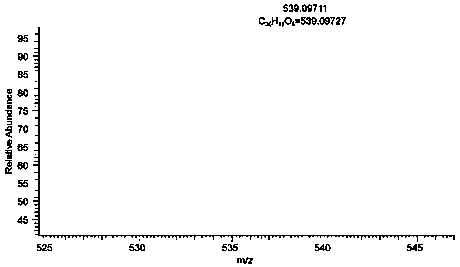Method for evaluating authenticity of lotus bee pollen
A technology for lotus bee pollen and bee pollen, which is applied in the directions of measuring devices, instruments, scientific instruments, etc., can solve problems such as deceiving consumers, and achieve the effect of easy operation and promotion and high content
- Summary
- Abstract
- Description
- Claims
- Application Information
AI Technical Summary
Problems solved by technology
Method used
Image
Examples
Embodiment 1
[0055] 1. Sample source
[0056] A total of 24 common real bee pollen samples were purchased from the market or beekeepers, namely rape bee pollen (3 parts), camellia bee pollen (3 parts), lotus bee pollen (3 parts), corn bee pollen (3 parts) , Rose Bee Pollen (3 parts), Codonopsis Bee Pollen (3 parts), Schisandra Bee Pollen (3 parts), Buckwheat Bee Pollen (3 parts). It is used to detect the content of biflavonoids in various bee pollens.
[0057] 2. sample handling
[0058] Grind bee pollen into powder, weigh 0.8 g of ground bee pollen, add 7.2 mL of extraction solution, vortex at room temperature until completely dissolved, and g , centrifuged at 4°C for 20 min. Collect the supernatant and pass it through a 0.22 µm filter; absorb 10 µL of the extract and dilute once with 990 µL of methanol-water; draw another 100 µL of extract: dilute once with 900 µL of methanol-water. The diluent was transferred to a sample vial for analysis on the machine.
[0059] 3. Q Exactive plu...
Embodiment 2
[0067] 1. Sample source
[0068] A total of 24 common real bee pollen samples were purchased from the market or beekeepers, namely rape bee pollen (3 parts), camellia bee pollen (3 parts), lotus bee pollen (3 parts), corn bee pollen (3 parts) , Rose Bee Pollen (3 parts), Codonopsis Bee Pollen (3 parts), Schisandra Bee Pollen (3 parts), Buckwheat Bee Pollen (3 parts). It is used to detect the content of biflavonoids in various bee pollens.
[0069] 2. Solution preparation
[0070] (1) Solution preparation
[0071] Extraction solution: pipette 20 mL of methanol, and dilute to 100 mL with ultrapure water. Store at 4°C.
[0072] Standard solution of abiflavones from A. spiconiae: Weigh 10 mg of abiflavones from A. spiconiae standard, and dilute to 10 mL with methanol. Store at 4°C, valid for 2 months.
[0073] 3. Q Exactive plus test conditions are as follows:
[0074] (1) Sample processing:
[0075] Grind bee pollen into powder, weigh 0.8 g of ground bee pollen, add 7.2 m...
Embodiment 3
[0097] 1. Sample source
[0098] Buy 20 kinds of commercial lotus bee pollen from the market.
[0099] 2. Experimental procedure
[0100] (1) Solution preparation
[0101] Extraction solution: pipette 20 mL of methanol, and dilute to 100 mL with ultrapure water. Store at 4°C.
[0102] AF standard solution: Weigh 10 mg of AF standard and dilute to 10 mL with methanol. Store at 4 ℃, valid for 2 months.
[0103] (2) Sample processing:
[0104] Grind bee pollen into powder, weigh 0.8 g of ground bee pollen, add 7.2 mL of extraction solution, vortex at room temperature until completely dissolved, and g , centrifuged at 4°C for 20 min. Collect the supernatant and pass it through a 0.22 µm filter; absorb 10 µL of the extract and dilute once with 990 µL of methanol-water; draw another 100 µL of extract: dilute once with 900 µL of methanol-water. The diluent was transferred to a sample vial for analysis on the machine.
[0105] (3) Blank bee pollen spiked:
[0106] Grind blan...
PUM
 Login to View More
Login to View More Abstract
Description
Claims
Application Information
 Login to View More
Login to View More - R&D
- Intellectual Property
- Life Sciences
- Materials
- Tech Scout
- Unparalleled Data Quality
- Higher Quality Content
- 60% Fewer Hallucinations
Browse by: Latest US Patents, China's latest patents, Technical Efficacy Thesaurus, Application Domain, Technology Topic, Popular Technical Reports.
© 2025 PatSnap. All rights reserved.Legal|Privacy policy|Modern Slavery Act Transparency Statement|Sitemap|About US| Contact US: help@patsnap.com



